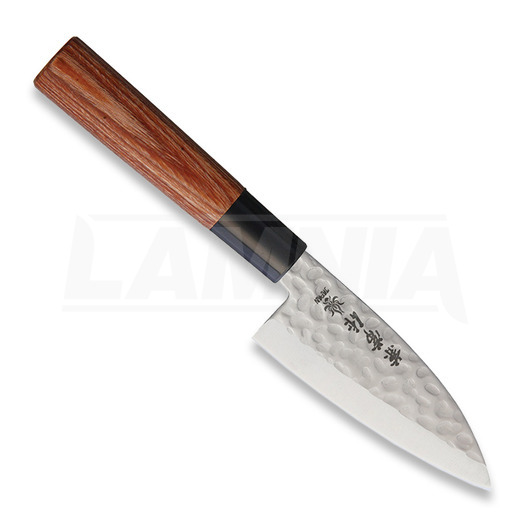A Ko deba knife is a Japanese-style knife that is used for filleting fish. It has a thick blade that is curved and blunt, making it ideal for cutting through fish bones. The handle of the knife is often made from wood or plastic, and the blade is usually stainless steel.
The Ko Deba is a Japanese kitchen knife that is used for slicing fish. It has a wide, blunt blade that is ideal for cutting through fish bones. The Ko Deba is also known as the Japanese butcher’s knife.
If you are looking for a knife to add to your sushi making supplies, then the Ko Deba is a great choice. This knife will help you make clean cuts of fish fillets, and it can also be used to chop vegetables.
The wide blade of the Ko Deba makes it a bit awkward to use at first, but with some practice, you’ll be slicing like a pro in no time.
Be sure to keep the blade sharpened so that it can make clean cuts through tough fish skin.
Ajikiri
An Ajikiri is a Japanese knife that is used for cutting fish. The blade of this knife is typically between six and eight inches long, and it has a curved edge that makes it ideal for slicing through fish flesh. This type of knife is also often used by sushi chefs to prepare sashimi, as the sharpness of the blade ensures that the fish will be cut cleanly and evenly.
Usuba Knife
Assuming you would like a blog post discussing the Usuba knife:
The Usuba is a traditional Japanese vegetable knife. It is characterized by its single-beveled edge and relatively thin blade, which makes it ideal for slicing vegetables with precision.
The word “usuba” actually refers to the cutting technique used with this type of knife, which is often described as “chiffonade.”
While the Usuba is most commonly used in professional kitchens, it is also becoming increasingly popular among home cooks who are looking for a versatile and durable kitchen tool. If you’re considering adding an Usuba to your collection of knives, here’s what you need to know about this essential Japanese kitchen tool.
The first thing to note about the Usuba is that it is a single-beveled knife. This means that only one side of the blade is sharpened, while the other side remains blunt. The angle of the bevel can vary depending on the intended use of the knife – for example, a more acute angle will produce a sharper edge but will also be more delicate and susceptible to chipping.
In contrast, a less acute angle will create a more durable edge but won’t be quite as sharp. When choosing an Usuba, it’s important to select one with a bevel angle that suits your needs and cooking style.
One of the main benefits of using an Usuba is its ability to create extremely thin slices of vegetables – something that can be difficult to achieve with other types of knives.
This makes it ideal for preparing dishes like sushi or sashimi, where uniformity and presentation are key. The thin blade also allows for greater control when slicing delicate ingredients like herbs or mushrooms.
If you’re looking for an all-purpose kitchenknife that can handle both big and small jobs alike, then theUsuba might just be the perfect option for you.
With its versatile sizeand razor-sharp edge, this traditional Japanese vegetable knifecan help you create beautiful dishes that are sure to impress yourfamily and friends!
Deba Knife Use
Deba knives are a type of Japanese knife that is typically used for slicing and dicing fish. The blade on a Deba knife is usually quite thick and heavy, which makes it ideal for cutting through thick fish bones. While Deba knives are not the most common type of Japanese knife, they are an essential tool for any sushi chef.
There are a few things to keep in mind when using a Deba knife. First, always use a cutting board that is larger than the blade of the knife. This will help protect your countertop or cutting surface from getting damaged.
Second, when slicing fish with a Deba knife, it is important to use a sawing motion rather than trying to chop through the fish. This will help you get cleaner slices and prevent the blade from getting stuck in the fish bones.
Finally, always be sure to wash your Deba knife immediately after use.
Fish can contain bacteria that can cause food poisoning if not properly cleaned off of the blade. By washing your knife right away, you can avoid any potential health risks associated with using a dirty knife.
Best Deba Knife
A deba knife is a Japanese-style knife that is used for filleting fish and preparing meat. It is also known as a “fish knife” due to its primary use. The blade of a deba knife is thick and heavy, making it ideal for cutting through bone.
The handle of a deba knife is typically octagonal in shape and made from wood or plastic.
Thedeba knife originated in Japan during the Edo period (1603-1868). It was originally used as a tool for butchering fish.
The blade of the knife was designed to be thick and heavy so that it could easily cut through bone. As the popularity of sushi and sashimi increased, so did the popularity of the deba knife.
Deba Vs Santoku
When it comes to kitchen knives, there are a lot of different options to choose from. If you’re looking for a versatile all-purpose knife, then you might be wondering if a deba or santoku is the right choice for you. Both of these Japanese knives can be used for a variety of tasks, but there are also some key differences between them.
Here’s a closer look at the deba vs santoku debate:
Deba:
– A deba is typically heavier than a santoku, which makes it ideal for chopping through thick cuts of meat or fish.
– The blade on a deba is usually narrower and sharper, making it better suited for precision tasks like filleting fish.
– Deba knives are typically single-beveled (meaning that they’re only sharpened on one side), which gives them a more aggressive cutting action. This makes them less suitable for delicate tasks like slicing vegetables.
Santoku:
– Santoku means “three virtues” in Japanese, referring to the three main types of cuts that this knife is designed for: slicing, dicing, and mincing.
– A santoku is lighter than a deba and has a shorter blade length, making it more maneuverable and easier to control.
Ajikiri Knife
An ajikiri knife is a type of Japanese kitchen knife. It is characterized by its thin, rectangular blade which is ideal for slicing and chopping vegetables. The ajikiri is also known for its sharpness and durability, making it a popular choice among professional chefs.

Credit: www.lamnia.com
What is a Ko Deba Knife?
A Ko deba knife is a Japanese kitchen knife used for cutting fish. The word “ko” means “blade”, while the word “deba” comes from the verb “to cut”. As such, these knives are designed specifically for slicing through fish flesh and bones.
They typically have a relatively thick blade, which makes them well-suited for this task. Ko deba knives are usually between 150mm and 210mm in length, with the most common size being 180mm.
While they can be used to cut other meats and vegetables, ko deba knives are really at their best when slicing through fish.
Their thick blades make short work of even the toughest fish bones, while their sharpness ensures that your cuts will be clean and precise. If you’re looking for a versatile Japanese kitchen knife that can handle just about anything, then a ko deba knife is definitely worth considering.
Can I Use a Deba Knife for Meat?
A Deba knife is a traditional Japanese knife that is typically used for slicing and filleting fish. However, because of its sharpness and sturdy construction, it can also be used for cutting meat.
If you are planning on using a Deba knife to cut meat, it is important to choose a piece of meat that is not too tough or sinewy.
The best cuts of meat for slicing with a Deba knife are boneless, skinless chicken breasts or pork loins. To make things easier, you can also ask your butcher to slice the meat for you.
When cutting meat with a Deba knife, it is important to use a slicing motion rather than sawing back and forth.
This will help to prevent the blade from becoming dull and will also result in cleaner slices of meat. It is also worth noting that because Deba knives are quite thick, they can be tricky to sharpen at home – so it’s best to leave this task to a professional!
Why are Japanese Kitchen Knives So Good?
Japanese kitchen knives are considered some of the best in the world for a few reasons. First, they’re usually made with high-quality steel that holds an edge well and is easy to sharpen. Second, Japanese knives often have a thinner blade than European knives, which makes them great for slicing and chopping vegetables.
Finally, many Japanese knife makers put a lot of time and effort into crafting their knives by hand, which results in beautiful and unique blades.
What Knife Do Japanese Chefs Use?
The most popular knife used by Japanese chefs is the Santoku knife. The Santoku knife is a versatile all-purpose kitchen knife that can be used for slicing, dicing and chopping. It has a slightly curved blade that makes it easy to rock back and forth when cutting, which is perfect for slicing through tough meats and vegetables.
The Santoku knife is also shorter and lighter than a Western chef’s knife, making it easier to handle for those with smaller hands.
Other popular Japanese knives include the Nakiri knife (a vegetable knife with a rectangular blade), the Usuba knife (a thinner vegetable knife) and the Yanagiba knife (a sushi and sashimi Knife).
What’s the Best Knife for Filleting Fish? Why the Deba is Perfect for Fish & Poultry
Conclusion
A Ko deba knife is a Japanese-style knife that is typically used for chopping fish. The blade is thick and heavy, making it ideal for cutting through fish bones. The handle of the knife is usually shorter than the blade, which makes it easy to control when chopping.
